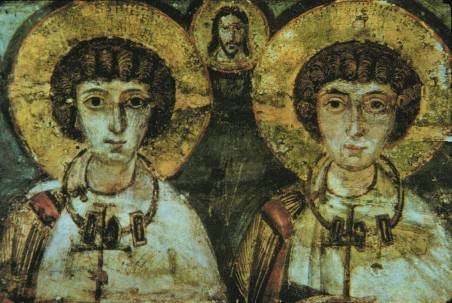Adelphopoiesis: A Lost Tradition of Love Beyond Bounds
How an Early Christian Brother-Making Rite Echoes Vedanta's Vision of Unity.
Adelphopoiesis may seem an unlikely tradition to analyze from the perspective of Vedantic philosophy at first glance. A lost Christian rite from medieval times, little known today, appears worlds apart from ancient Indian spiritual philosophies. Yet at their core, adelphopoiesis, and Vedanta share profound contemplations on life's deepest meaning.
Adelphopoiesis, meaning "brother-making," was an early Christian ceremony that united two men in a covenant as sacred as marriage. Emerging around the 6th century, it spread among Eastern churches and endured for 700 years. In the rite of adelphopoiesis, two men would declare before the clergy their commitment to care for each other as brothers for life. They pledged mutual support, legal rights, and even shared living arrangements and property—all the hallmarks of marriage apart from a sexual relationship.
For centuries, adelphopoiesis co-existed with marriage, affording same-sex couples in committed unions the opportunity to gain community recognition and blessing. Though not explicitly considered a romantic partnership, its sacredness and comprehensiveness made it parallel to marriage in nearly every other sense. The union of souls it signified transcended that of the body alone.
Adelphopoiesis faded into obscurity by the 13th century for reasons that remain unclear. However, its long history proves that same-sex relationships received sanction within medieval Christianity, contrary to widespread belief. At its heart, adelphopoiesis reflected the power of spiritual kinship and love to overcome earthly boundaries. This timeless message resonates with Vedanta's vision of the unity that underlies all things and the freedom from limitation found in moksha or spiritual liberation.
Though adelphopoiesis was a specifically Christian tradition, its implications extend far beyond any single faith. It gives hope that religious doctrine and human law might one day defend people's right to forge their own paths to purpose and belonging—however unconventional. The story of adelphopoiesis is one of love, and love's triumph over division. This is a truth both eternal and universal, echoed in Vedanta and the shared heart of all humanity.
Overcoming duality: Adelphopoiesis transcended the dualism between romantic/sexual love and spiritual kinship. It combined eros and agape, representing a union of body, mind, and soul. This reflects the Vedantic notion of non-duality, or Advaita, which sees an underlying unity of all things.
Finding oneness: The ceremony of adelphopoiesis affirmed that two individuals could share an essential sameness that overcame their differences. Their bond represented a profound recognition of the oneness they shared in God/the Divine. This parallels the Vedantic concept of the atman or the essential self that unites all beings.
Transcending boundaries: Adelphopoiesis allowed two men to form a union that transcended conventions, going beyond worldly notions of gender, sex, and even the body. Their partnership pointed to a deeper connection of spirit. This reflects the Vedantic idea of moksha or spiritual liberation, freeing oneself from limited and limiting identities.
Embracing love: At its heart, adelphopoiesis represented the boundless power of love. It showed that love cannot be constrained or defined by societal norms or doctrines. This resonates with the Vedantic view of devotion, bhakti, in which loving God/the Divine eclipses all else. Divine love transcends human boundaries and embraces all.
Finding purpose: The union formed through adelphopoiesis had a profound sense of purpose and meaning, as a path to spiritual realization with another. This aligns with the Vedantic concept of dharma, living one's purpose and spiritual duty. For those united in adelphopoiesis, this purpose was a shared journey of devotion unto the Divine.
In all these ways, adelphopoiesis pointed to a non-dualistic vision of reality as articulated in Vedanta. It represented a breaking down of illusory boundaries to find the deeper unity that underlies all things. Though a lost tradition, the message at its heart—that love transcends human limits and leads to spiritual awakening—remains a timeless one that resonates with Vedantic thought.
I have woven tales to share, for any who care to read them. My books await you on Google Books if you'll join me. Just follow this link and scroll down.




